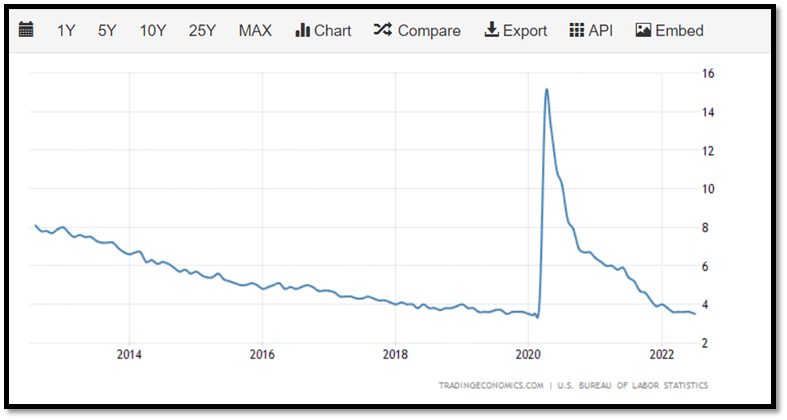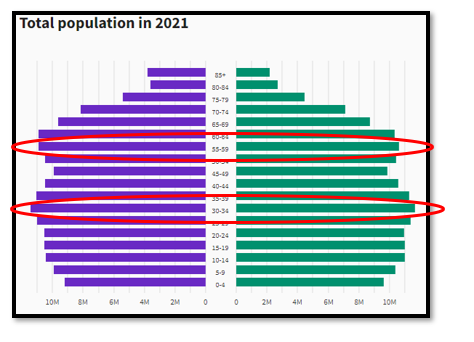Ready or Not, Here We Come!

Increased wages, labor shortages, The Great Resignation, OH MY! If you work anywhere in the wood supply chain, I guarantee that you have heard these terms on repeat over the last year or longer. Like me, you probably wonder, “Where did everyone go?”. Could someone actually live off a stimulus check without returning to work for this long? Surely those with even the best money management skills couldn’t spread $3,200 over the course of two years. With no clear, logical explanation, I went looking for answers and explanations. The following assessment is based on my interpretation of publicly available data. I strongly encourage everyone to review it and develop their own opinions.
The first statistic I reviewed in my search for answers was our National Unemployment Rate.

Figure 1: Tradingeconomics.com
As you can see in Figure 1, unemployment rates have returned to the “pre-covid” norm, telling me that we really no longer have a slew of working-age citizens without a job. So, if the vast majority of working-age citizens are at work, and we are still experiencing a labor shortage, does this mean we have a “shortage” of citizens?
This question led me to research U.S. population trends to find more answers.

Figure 2: USAFacts.org
At first glance, Figure 2 looked exactly how I had expected. In my 28 years here on earth, I can recall a lot of different propaganda related to threats of overpopulation. Looking at the trend, I can personally understand why. However, what really stood out to me was the plateau that has recently taken shape in the years 2020-2021. Is that flat line enough to explain a labor shortage of this proportion? As I continued to scroll through the website looking for more answers, I found age demographics that, to me, best explain how we found ourselves in our current situation.

Figure 3: USAFacts.org
Figure 3 shows the current US male/female age demographic broken down by 5-year age groups. I have added red circles signifying the general peak of the Boomer generation and the general peak of the Millennial generation. After spending some time analyzing this graph, it became obvious to me that while the “Great Resignation” may have been accelerated by COVID, it would have been here and now either way. Think about it. The Boomer generation has spent the last 40-50 years chasing and accomplishing dreams that have brought their industries, our nation, and our economy to where it is today. Generally, they heeded the advice of their parent’s generation to save as many pennies as possible and invest them into retirement. Point blank, they have earned it, and it is time for them to enjoy what they have worked so hard to achieve. However, that now leaves us with an overlap in two “mega” generations consuming goods, with only one of those generations here to supply them. (Note: My intent with that statement is not to oversimplify the age demographics in the figure but to help focus more on the macroeconomics at play.) To me, this best explains the Great Resignation, labor shortages, and wage increases while also leading me to think of solutions to grow our available workforce that don’t include waiting on the next baby boom.
So when demand outweighs supply due to available capacity, you have to find ways to increase the productivity and efficiency of the equipment you have. To me, if we apply this to the Millennial generation, it boils down to three separate solutions: automation, digitization, and immigration.
Automation: Has anyone else noticed the increased use of self-checkouts and kiosks since the onset of COVID? What was once generally localized to large retail and grocery stores, you can now find self-checkouts in gas stations and fast-food restaurants. I don’t think I have ordered a cheeseburger from a living, breathing person in months. In order to compete and remain successful as an industry, we will need to follow these automation trends. Self-driving trucks may give us all visions of The Jetsons, but it’s a reality that I think we should give more attention to before it’s too late.
Digitization: One of the best and most powerful tools the millennial generation has in its toolbox is the experience of growing up in the middle of the technological revolution. Calculations once done with a slide rule are now done with smartphones. Analytics that once required the experience of the most veteran employees of the company are now done in a matter of minutes with nothing more than point-and-click efforts. To keep up with two generations worth of demand, Millennials will have to find ways to be more productive with our time. The best way to do that will be through digitizing and fully embracing the technology available to us.
Immigration: We will need to increase our workforce through legal immigration and migrant guest workers to help fill gaps and meet demand where automation and digitization cannot. Advocating for and fully utilizing programs that correctly allow migrants to come to the US is one of the best ways to ensure we are able to meet the demand ahead of us. Supporting associations such as FRA that are willing to lobby for programs like H-2B guest worker visas can help our industry stay ahead of the supply/demand imbalance that we live in today.
One thing is for sure – we should all embrace the reality that the Boomer generation has begun its exodus from the workforce, a migration that is well-earned. It is time for the Millennial generation to rise to the labor challenge ahead of us by leveraging our unique skill set and the knowledge passed down from those that came before us. Ready or not, here we come!
References
United States Unemployment Rate – July 2022 Data – 1948-2021 Historical (tradingeconomics.com)
US population by year, race, age, ethnicity, & more | USAFacts


